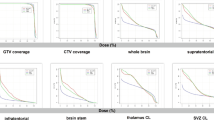Abstract
Background
To reduce this complication and to enhance the radiation effect to hypoxic cells of high-grade gliomas, the authors performed noninvasive fractionated stereotactic radiotherapy (FSRT) using a Gamma unit combined with hyperbaric oxygen (HBO) therapy for the treatment of recurrent disease.
Patients and methods
Twenty-five consecutive patients who had previously received radiotherapy with chemotherapy for recurrent high-grade gliomas, including 14 patients with anaplastic astrocytoma (AA) and 11 with glioblastoma multiforme (GBM), underwent Gamma FSRT immediately after HBO therapy (2.5 atmospheres absolute for 60 min). The Gamma FSRT was repeatedly performed using a relocatable head cast. Median tumor volume was 8.7 cc (range, 1.7–159.3 cc), and the median total radiation dose was 22 Gy (range, 18–27 Gy) to the tumor margin in 8 fractions.
Results
Actuarial median survival time after FSRT was 19 months for patients with AA and 11 months for patients with GBM, which was significantly different (P = 0.012, log-rank test). Two patients underwent subsequent second FSRT for regional or remote recurrence. Seven patients (28%) underwent subsequent craniotomies and resections at a mean of 8.4 months after FSRT treatment, and 4 of them had radiation effects without viable cells and remained alive for 50–78 months.
Conclusion
Gamma FSRT after HBO therapy appears to confer a survival benefit for patients with recurrent high-grade gliomas and warrants further investigation.

Similar content being viewed by others
References
Larson DA, Gutin PH, McDermott M et al. (1996) Gamma knife for glioma: selection factors and survival. Int J Radiat Oncol Biol Phys 36:1045–1053
Cho KH, Hall WA, Gerbi BJet al. (1999) Single dose versus fractionated stereotactic radiotherapy for recurrent high-grade gliomas. Int J Radiat Oncol Biol Phys 45:1133–1141
Hudes RS, Corn BW, Werner-Wasik M et al. (1999) A phase I dose escalation study of hypofractionated stereotactic radiotherapy as salvage therapy for persistent or recurrent malignant glioma. Int J Radiat Oncol Biol Phys 43:293–298
Shepherd SF, Laing RW, Cosgrove VP et al. (1997) Hypofractionated stereotactic radiotherapy in the management of recurrent glioma. Int J Radiat Oncol Biol Phys 37:393–398
Kohshi K, Kinoshita Y, Imada H et al. (1999) Effects of radiotherapy after hyperbaric oxygenation on malignant gliomas. Br J Cancer 80:236–241
Ogawa K, Yoshii Y, Inoue O et al. (2003) Prospective trial of radiotherapy after hyperbaric oxygenation with chemotherapy for high-grade gliomas. Radiother Oncol 67:63–67
Kleihues P, Burger PC, Scheithauer BW (1993) Histological Typing of Tumours of the Central Nervous System 2nd Ed. Springer-Verlag, Berlin
Yamamoto H, Takagi M, Ushio Y, Ohno S. (1998) Gamma knife radiosurgery for multiple metastatic brain lesions Neurosurg Lett 8:391–398 (in Japanese, no English abstract)
Simonova G, Novotny J, Novotny J Jr et al. (1995) Fractionated stereotactic radiotherapy with the Leksell Gamma Knife: feasibility study. Radiother Oncol 37:108–116
Kaplan EL, Meier P (1958) Non-parametric estimation from incomplete observations. J Am Stat Assoc 53:457–481
Mantel N (1966) Evaluation of survival data, two new rank order statistics arising in its consideration. Cancer Chemother Rep 50:163–170
Wallner KE, Galicich JH, Krol G et al. (1989) Patterns of failure following treatment for glioblastoma multiforme and anaplastic astrocytoma. Int J Radiat Oncol Biol Phys 16:1405–1409
Patel S, Breneman JC, Warnick RE et al. (2000) Permanent iodine-125 interstitial implants for the treatment of recurrent glioblastoma multiforme. Neurosurgery 46:1123–1128
Simon JM, Cornu P, Boisserie G et al. (2002) Brachytherapy of glioblastoma recurring in previously irradiated territory: predictive value of tumor volume. Int J Radiat Oncol Biol Phys 53:67–74
Shrieve DC, Alexander III E, Wen PY et al. (1995) Comparison of stereotactic radiosurgery and brachytherapy in the treatment of recurrent glioblastoma multiforme. Neurosurgery 36:275–284
Kondziolka D, Flickinger JC, Bissonette DJ et al. (1997) Survival benefit of stereotactic radiosurgery for patients with malignant glial neoplasms. Neurosurgery 41:776–785
Inoue HK, Hayashi S, Ishihara J et al. (1995) Fractionated Gamma Knife radiosurgery for malignant gliomas: neuroimaging effects and FDG-PET studies. Stereotact Funct Neurosurg 64(suppl 1):249–257
Regine WF, Patchell RA, Strottmann JM et al. (2000) Preliminary report of a phase I study of combined fractionated stereotactic radiosurgery and conventional external beam radiation therapy for unfavorable gliomas. Int J Radiat Oncol Biol Phys 48:421–426
Miranpuri AS, Tome WA, Paliwal BR et al. (2001) Assessment of patient-independent intrinsic error for a noninvasive frame for fractionated stereotactic radiotherapy. Int J Cancer (Radiat Oncol Invest) 96:320–325
Fowler JF. (1989) The linear-quadratic formula, progress in fractionated radiotherapy. Br J Radiol 62:679–694
Hall EJ (1994) Radiobiology for the Radiologists. Philadelphia, Lippincott, pp 133–152
Rampling R, Cruickshank G, Lewis AD et al. (1994) Direct measurement of pO2 distribution and bioreductive enzymes in human malignant brain tumors. Int J Radiat Oncol Biol Phys 29:427–431
Collingridge DR, Piepmeier JM, Rockwell S, Knisely. (1999) Polarographic measurements of oxygen tension in human glioma, surrounding peritumoural brain tissue. Radiother Oncol 53:127–131
Kunugita N, Kohshi K, Kinoshita Y, et al. (2001) Radiotherapy after hyperbaric oxygenation improves radioresponse in experimental tumor model. Cancer Lett 164:149–154
Kinoshita Y, Kohshi K, Kunugita N et al. (2000) Preservation of tumour oxygen after hyperbaric oxygenation monitored by magnetic resonance imaging. Br J Cancer 82:88–92
Beppu T, Kamada K, Yoshida Y et al. (2002) Change of oxygen pressure in glioblastoma tissue under various conditions. J Neurooncol 58:47–52
Author information
Authors and Affiliations
Corresponding author
Rights and permissions
About this article
Cite this article
Kohshi, K., Yamamoto, H., Nakahara, A. et al. Fractionated stereotactic radiotherapy using gamma unit after hyperbaric oxygenation on recurrent high-grade gliomas. J Neurooncol 82, 297–303 (2007). https://doi.org/10.1007/s11060-006-9283-1
Received:
Accepted:
Published:
Issue Date:
DOI: https://doi.org/10.1007/s11060-006-9283-1




